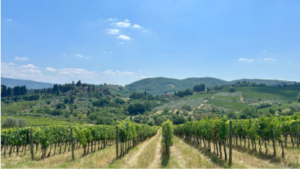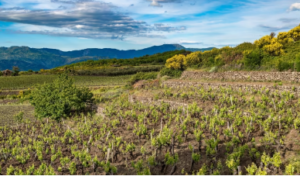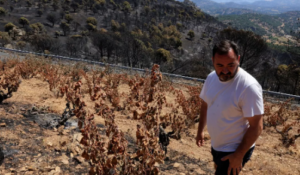Keywords: Europe wineries, extreme heat, climate change, wine production decline, Assyrtiko grape extinction, wine policy, EU wine industry
As extreme heat and climate change continue to ravage Europe’s vineyards, the region’s storied wine industry faces unprecedented challenges. Southern Europe, renowned for its fine wines, is experiencing significant production declines, threatening both the quality and quantity of its output.
Severe Impact on Wine Production
In 2023, global wine production plummeted by 10% to just 237.3 million hectolitres, the lowest level in over 60 years. This decline is largely attributed to extreme climatic conditions, including severe heat waves and unpredictable weather patterns. Southern European countries, including Greece, Italy, and Spain, have been hit hardest, with substantial drops in production.
Yiannis Paraskevopoulos, co-founder of Greece’s Gaia Wines, reveals the stark reality for Santorini’s iconic Assyrtiko grape. Once a staple of the island’s fine white wines, Assyrtiko production has fallen dramatically, with last year’s yield at only one-third of 2022 levels. This year, the harvest is expected to be a mere one-sixth of 2022’s output. According to Paraskevopoulos, the grape could face extinction as early as 2040, though current trends suggest this timeline may be even shorter.

Rising Costs and Declining Consumption
The dramatic reduction in production is driving up costs, with the price of Assyrtiko grapes doubling compared to 2022. This surge in prices is pushing consumers away, with global wine consumption falling by 2.6% in 2023. Higher production and distribution costs are contributing to this decline, as wine prices reach levels comparable to premium Champagne.
Adaptation Strategies in the Industry
In response to these challenges, winemakers are adopting new production techniques. For instance, Antinori nel Chianti Classico in Italy has started planting vines in new orientations to optimize sun exposure and employing methods to improve air circulation and water efficiency. Similarly, Spanish wine group Raventós Codorniu is using buried irrigation systems to enhance water use efficiency.
Greece’s Domaine Skouras has also adjusted its practices, starting harvests earlier and planting vineyards at higher altitudes to mitigate the effects of extreme heat. Despite these efforts, overall yields remain lower than previous years.
Tourism’s Role and Future Prospects
Increased tourism in wine regions like Santorini has shifted resources away from traditional vineyard maintenance, contributing to the production crisis. While tourism can provide financial support, it also diverts investment from agriculture to hospitality.
The European Union has recognized the urgency of the situation and has launched a high-level group on wine policy to address the sector’s challenges. The group is expected to meet several times throughout the year and present recommendations in early 2025.
The Path Forward
As the wine industry grapples with climate-induced challenges, the future of Europe’s vineyards hangs in the balance. Industry leaders and policymakers face a critical task: to intervene effectively and adapt in time to preserve the continent’s rich wine heritage.

Impact of Extreme Heat on Wine Production
Global Decline: The global wine production dropped by 10% in 2023 to 237.3 million hectolitres, a level not seen in over six decades. This significant reduction is primarily due to extreme weather conditions affecting key wine-producing regions.
Southern Europe’s Struggles: Countries like Greece, Italy, and Spain have been particularly hard-hit. Production in Greece fell by over one-third in 2023. In Italy and Spain, output dropped by more than 20% due to heavy rainfall, drought, and early frosts.
2. The Assyrtiko Grape Crisis
Santorini’s Wine Industry: The Assyrtiko grape, a key variety for Santorini’s renowned wines, is under severe threat. Last year’s production was about one-third of 2022 levels, and this year’s harvest is expected to be as low as one-sixth of 2022’s output.
Extinction Risk: Gaia Wines’ Yiannis Paraskevopoulos warns that Assyrtiko could face extinction by 2040. Given current trends, this prediction might be optimistic, with the timeline potentially accelerating.
3. Economic Impact
Rising Costs: The price of Assyrtiko grapes has surged to 8-10 euros per kilogram, double the 2022 price. This increase in production costs is contributing to higher wine prices, affecting consumer purchasing behavior.
Consumption Decline: Global wine consumption fell by 2.6% in 2023, reaching its lowest level since 1996. The decline is attributed to higher prices driven by increased production and distribution costs.
4. Adaptation Measures
Production Adjustments:
Antinori nel Chianti Classico: This winery in Italy is adjusting vineyard orientations to take advantage of increased sun exposure and is raising trellises for better air circulation.
Raventós Codorniu: In Spain, the company is focusing on efficient water use with buried irrigation systems.
Early Harvests: Domaine Skouras in Greece has started harvesting 20 days earlier than usual. The winery is also planting vines at higher altitudes to escape the extreme heat.
5. Impact of Tourism
Shifting Resources: Increased tourism in regions like Santorini has diverted investment and manpower from traditional vineyard work to hospitality services. This shift is exacerbating the production issues.
Agritourism Benefits: Some wineries, such as Castello di Volpaia in Tuscany, are leveraging agritourism to offset financial losses. This includes offering accommodation and tours to attract visitors.
6. Policy and Future Prospects
EU Intervention: The European Union has formed a high-level group to address the challenges facing the wine sector. The group will meet several times this year and is expected to present recommendations by early 2025.
Industry Concerns: There is a pressing need for effective interventions to mitigate the risks to the wine industry. Stakeholders are concerned about the long-term sustainability of Europe’s viticulture under current climate conditions.
Europe’s wine industry is facing a critical juncture as extreme heat and climate change threaten its traditional practices and economic viability. With production declines, rising costs, and shifting resources due to tourism, the future of European wineries hinges on adaptive strategies and timely policy interventions.

